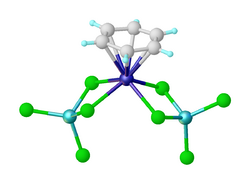Chemistry:Transition metal arene complex
thumb|114px|Structure of Cr(η6-C6H6)2 Metal arene complexes are organometallic compounds of the formula (C6R6)xMLy. Common classes are of the type (C6R6)ML3 and (C6R6)2M. These compounds are reagents in inorganic and organic synthesis. The principles that describe arene complexes extend to related organic ligands such as many heterocycles (e.g. thiophene) and polycyclic aromatic compounds (e.g. naphthalene).[1]
Synthesis

Fischer–Hafner synthesis
Also known as reductive Friedel–Crafts reaction, the Fischer–Hafner synthesis entails treatment of metal chlorides with arenes in the presence of aluminium trichloride and aluminium metal. The method was demonstrated in the 1950s with the synthesis of bis(benzene)chromium by Walter Hafner and his advisor E. O. Fischer.[3] The method has been extended to other metals, e.g. [Ru(C6Me6)2]2+. In this reaction, the AlCl3 serves to remove chloride from the metal precursor, and the Al metal functions as the reductant.[1] The Fischer-Hafner synthesis is limited to arenes lacking sensitive functional groups. thumb|114px|Structure of Mo(η6-C6H3Me3)(CO)3.
Direct synthesis
By metal vapor synthesis, metal atoms co-condensed with arenes react to give complexes of the type M(arene)2. Cr(C6H6)2 can be produced by this method.[1]
Cr(CO)6 reacts directly with benzene and other arenes to give the piano stool complexes Cr(C6R6)(CO)3.[4] The carbonyls of Mo and W behave comparably. The method works particularly well with electron-rich arenes (e.g., anisole, mesitylene). The reaction has been extended to the synthesis of [Mn(C6R6)(CO)3]+:
- BrMn(CO)5 + Ag+ + C6R6 → [Mn(C6R6)(CO)3]+ + AgBr + 2 CO
From hexadienes
Few Ru(II) and Os(II) complexes react directly with arenes. Instead, arene complexes of these metals are typically prepared by treatment of M(III) precursors with cyclohexadienes. For example, heating alcohol solutions of 1,3- or 1,4-cyclohexadiene and ruthenium trichloride gives (benzene)ruthenium dichloride dimer. The conversion entails dehydrogenation of an intermediate diene complex.
Alkyne trimerization
Metal complexes are known to catalyze alkyne trimerization to give arenes. These reactions have been used to prepare arene complexes. Illustrative is the reaction of [Co(mesitylene)2]+ with 2-butyne to give [Co(C6Me6)2]+.[1]
Structure
In most of its complexes, arenes bind in an η6 mode, with six nearly equidistant M-C bonds. The C-C-C angles are unperturbed vs the parent arene, but the C-C bonds are elongated by 0.2 Å. In the fullerene complex Ru3(CO)9(C60), the fullerene binds to the triangular face of the cluster.[5]

η4- and η2-Arene complexes
In some complexes, the arene binds through only two or four carbons, η2 and η4 bonding, respectively. In these cases, the arene is no longer planar. Because the arene is dearomatized, the uncoordinated carbon centers display enhanced reactivity. A well studied example is [Ru(η6-C6Me6)(η4-C6Me6)]0, formed by the reduction of [Ru(η6-C6Me6)2]2+. An example of an [Os(η2-C6H6)(NH3)5)]2+.[6]
Reactivity
When bound in the η6 manner, arenes often function as unreactive spectator ligands, as illustrated by several homogeneous catalysts used for transfer hydrogenation, such as (η6-C6R6)Ru(TsDPEN). In cationic arene complexes or those supported by several CO ligands, the arene is susceptible to attack by nucleophiles to give cyclohexadienyl derivatives.
Particularly from the perspective of organic synthesis, the decomplexation of arenes is of interest. Decomplexation can often be induced by treatment with excess of ligand (MeCN, CO, etc).[4]
References
- ↑ 1.0 1.1 1.2 1.3 Pampaloni, G. (2010). "Aromatic Hydrocarbons as Ligands. Recent Advances in the Synthesis, the Reactivity and the Applications of Bis(η6-arene) Complexes". Coordination Chemistry Reviews 254 (5–6): 402–419. doi:10.1016/j.ccr.2009.05.014.
- ↑ Thewalt, U.; Stollmaier, F. (1982). "Structurchemie titanorganischer verbindungen: die structur von η6-C6H6Ti(Cl2AlCl2)2". J. Organomet. Chem. 228 (2): 149–152. doi:10.1016/S0022-328X(00)87093-X.
- ↑ Seyferth, D. (2002). "Bis(benzene)chromium. 2. Its Discovery by E. O. Fischer and W. Hafner and Subsequent Work by the Research Groups of E. O. Fischer, H. H. Zeiss, F. Hein, C. Elschenbroich, and Others". Organometallics 21 (14): 2800–2820. doi:10.1021/om020362a.
- ↑ 4.0 4.1 E. Peter Kündig (2004). "Synthesis of Transition Metal h6-Arene Complexes". Topics Organomet Chem.. Topics in Organometallic Chemistry 7: 3–20. doi:10.1007/b94489. ISBN 978-3-540-01604-5.
- ↑ Hsu, Hsiu-Fu; Shapley, John R. (1996). "Ru3(CO)9(μ3-η2,η2,η2-C60): A Cluster Face-Capping, Arene-Like Complex of C60". J. Am. Chem. Soc. 118 (38): 9192. doi:10.1021/ja962077m.
- ↑ Liebov, Benjamin K.; Harman, W. Dean (2017). "Group 6 Dihapto-Coordinate Dearomatization Agents for Organic Synthesis". Chemical Reviews 117 (22): 13721–13755. doi:10.1021/acs.chemrev.7b00480. PMID 29064228.
 |

